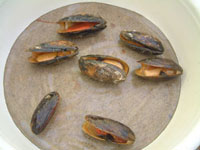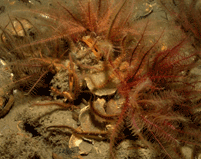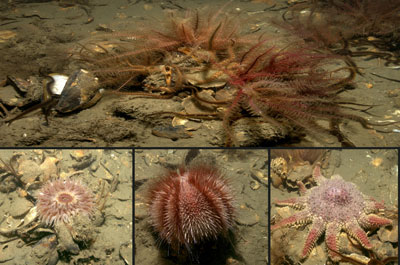What is Modiolus?
What is Modiolus?

- Modiolus modiolus is commonly known as the horse mussel. It is a marine bivalve also known in Scotland as Clabach Dubh and in the Shetlands as the Yaug (Comely, 1981).
- Ranges in size from 35 to 200mm.
- Lives up to 50 years on a variety of seabed subtrates including bedrock, gravel, sand and, most rarely mud.
- Occurs in pools in the lower eulittoral zone to depths over 100m.
- Forms biogenic reefs.
- Widely distributed in the Northern Hemisphere (). In Europe, it is found from the Barents and White Seas to the Bay of Biscay. In the UK and Ireland it is absent south of the Irish Sea and Humber Estuary. Outside Europe the horse mussel is present off the Atlantic coast of North America, from Labrador to South Carolina and in the Pacific (Bering Sea, Japan and west coast of North America).


The Modiolus reefs of Strangford Lough - a diverse marine ecosystem
The horse mussel Modiolus modiolus forms 'beds' or ‘reefs’ that under the EC Habitats Directive (92/43/EEC) are classified as sublittoral biogenic reefs. These Modiolus reefs form large and continous banks or isolated clumps. The Modiolus reefs of Strangford Lough enable a very rich faunal community that includes most of the major groups of organisms and this habitat is regarded as one the most luxuriant biotopes in the North-East Atlantic.
In Strangford Lough - a large (150km²) shallow sea lough situated on the east coast of County Down, Northern Ireland - M. modiolus forms clumped biogenic reefs which are unusual as they are located in areas of very soft substratum. Only in the Fith of Forth (Scotland) and the San Juan Channel (North-America) are Modiolus reefs found in soft substrates. Strangford Lough has a high detritus and plankton load which combined with a high water movement provides excellent conditions for filter feeders such as oysters and mussels.
Horse mussel reefs provide multiple ecosystem services including improved water quality and enhanced production of economically important shellfish. The mussels have a high filtration capacity (1 mussel filters about 1L water per hour while 1000 mussels can filter about 24 tonnes water per day) which increases water clarity and promotes nitrogen removal. The comples reefs also provide food and shelter for many organisms which results in greater production of shellfish compared to bare substrate. Reefs likely benefit multiple fisheries including multiple species of commercially harvested scallops and crabs.

Horse mussel reefs are considered to be one of the most diverse marine ecosystems in Europe. Top photo: Modiolus clump with Antedon bifida; bottom images, from left to right: Dahlia Anemone Urticina felina, sea urchin Echinus esculentus and starfish Solaster paposus (Photo: Bernard Picton).
